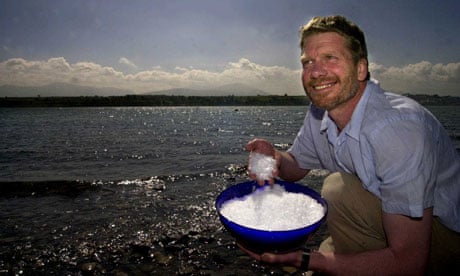In a pristine shed on the edge of a field overlooking the grey ribbon of sea that separates the isle of Anglesey from the mainland of Wales, David Lea-Wilson lifts a stainless steel shovel from a basin of brine and inspects what's in it: big, beautiful, crystalline white flakes, glistening almost gem-like under the striplights. He nods.
"Always difficult, trying to produce a standard product from a living resource," he says. "The seawater changes almost every day, but these have to be pretty much the same: crisp and pure; flakey but not too flakey; big but not too big; strong enough not to dissolve on hot food; not so strong as to break a tooth. But these look good."
Precious stuff, salt. There have been times when it has traded for twice the price of gold. Roman soldiers were paid a "salarium", either a payment in salt or an allowance to buy salt, but in any case the origin of our word salary. Wars have been fought for salt. An exorbitant salt tax fuelled the French revolution, and Mahatma Gandhi's march against the Raj salt monopoly launched Indian independence.
It is the condiment we can't live without – literally: sodium is essential to human life; it keeps our body fluids at the right concentration and helps our cells absorb nutrients. But too much of it is linked to high blood pressure, heart disease and strokes. The NHS recommends that adults should have no more than 6g of salt (2.5g of sodium) a day – about a teaspoon – but reckons many of us have nearer 10g, because most of the salt we eat is in bread, cereals, snacks and ready meals.
Food manufacturers are addressing this, and our overall salt consumption is falling. But the market for gourmet salt is booming: where once all we knew was table salt, sales of artisan and sea salts, now about a fifth of the UK total, are growing by as much as 10% a year. Food emporia such as Fortnum & Mason, which wouldn't dream of selling any other kind, have reported a 50% increase over the past five years; even Sainsbury's has seen sales of sea salt surge nearly 20%.
Artisan sea salt-making was once a major activity in Britain: But the discovery of massive underground rock salt deposits in Cheshire, and their industrial exploitation from the 19th century on, put paid to almost all that. Mined salt was cheap, refined and – thanks to the addition of assorted chemicals – free-flowing. It appealed to us, until quite recently, when we began to realise it was also boring and, worse, unpalatably bitter.
"Sea salt retains 70-odd natural trace elements that mostly get stripped out in industrial table salts," says Lea-Wilson, whose Halen Mon Anglesey Sea Salt company – started with his wife Alison, in 1996, with saucepans of seawater on the family Aga – now sells a million-plus tubes of sea salt a year in 23 countries, and graces the tables of such distinguished eateries as Heston Blumenthal's The Fat Duck and Ferran Adria's El Bulli. "It has a rounder, almost sweeter taste to it. And you get a much saltier hit for far less sodium."
Halen Mon is expensive (£5.50 for 250g) nearly twice the price of traditional Maldon sea salt and its other, more recent rival, Cornish Sea Salt, but that simply reflects what it costs to make, says Lea-Wilson: the salt crystals are harvested, rinsed, dried and packed, entirely by hand.
When the Lea-Wilsons started 15 years ago, business experts said there was no market for artisan sea salt. But over a decade in which many people have become more interested in what is on their plates, the company's success – demand has always outstripped supply – does not overly surprise them. "There are even restaurants in America that employ 'selmeliers' to advise diners on which salt to choose for which dish," says Alison.
To ensure we don't eat more than the recommended amount of salt, as well as eating less processed food, we can use a few choice crystals of real salt rather than the blander alternative. "If you loved wine but had been told to cut down," says Alison, "you'd drink less but buy the best you could, wouldn't you? Then enjoy every last drop."
Know your salts
▶ Flavoured sea salts
Smoked salt with eggs and chicken; celery salt for casseroles; vanilla salt with fish; spiced salt for roasts.
▶ Fleur de Sel
Pricey French sprinkling salt.
▶ Hawaian black lava salt and Alaea red clay salt
Good with most meats and seafoods.
▶ Indian Kala namak
Black, smells of rotten eggs – good with exotic fruits and chutneys.
▶ Truffle salt
For an affordable whiff of truffle.
▶ Himalayan pink salt and Australian Murray River salt
Exotic alternatives to regular sea salt.
